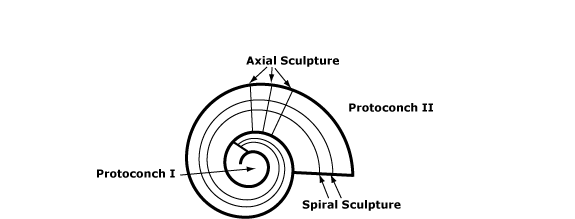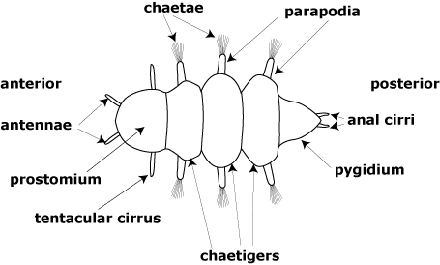 |
Photographic Identification Guide to Larvae at Hydrothermal Vents in the Eastern Pacific
|
Gastropod terminology
With a few exceptions, we photographed the protoconchs in the apical view, with the aperture on
the bottom right-hand side of the picture, as illustrated in the diagram
below. This is the side that remains visible after the larva settles and begins post-larval growth, so the photos can be directly compared to juveniles and adults that have retained their protoconchs. The more proximal ("posterior") portions are to the left in the diagram, the more distal ("anterior") to the right. The axis of coiling is the point around which the coil of the shell rotates. Most of these larvae are planispiral, or nearly so, meaning that their coiling is more or less in one plane. This gives them a sort of pseudo-bilateral symmetry and we will sometimes refer loosely to the “base” (at the bottom left-hand side of the diagram) and the “height” of the shell, as well as to the “right” side (facing out of the page in the diagram), the “left” side (facing into the page in the diagram), the “bottom” (the view with the aperture facing out of the page) and the “top” (the view with the aperture facing into the page). Many of these protoconchs have an aperture rim; usually this is visible only with the light microscope.

Most of these larvae have some form of sculpture on their shells. In the planispiral species, there are three types, with some degree of overlap. Pitted sculpture, which is typical of the Family Lepetodrilidae, consists of depressions in the surface of the shell. These may be small or large, shallow or deep and may be widely scattered or so close together that the entire surface of the shell is pitted. Sometimes the pits may follow the curve of the shell, so that the sculpture appears to form lines. Pitted sculpture often appears grainy under the light microscope.
Lineate sculpture, found in the Family Peltospiridae, is a series of regularly-spaced ridges that follow the curvature of the shell. The lines usually start at the axis of coiling, though there are exceptions, and extend most of the way to the aperture. There may be other forms of sculpture present as well, such as tubercles - raised bumps - as found in Lirapex granularis.
Reticulate sculpture is formed by raised ridges, but instead of following the curvature of the shell, they spread out to form a mesh. This network may be very regular and interconnected or consist of relatively few irregularly forking lines. Sometimes the mesh covers the entire shell; more commonly it is limited to the more proximal portions of the shell. This kind of sculpture is found in the Neomphalidae.

For coiled forms we use slightly different terminology. These shells generally show two different growth stages, often with different types of sculpture. The earliest shell, protoconch I (PI), usually is formed while the larva is non-feeding, the second, protoconch II (PII) is formed after the larva begins feeding in the plankton. All of these shells are right-handed, meaning that when the shell is oriented with the apex at the top and the aperture opening facing out of the page, the aperture will be to the right. Our photographs usually show both the apical view, to illustrate PI, and the aperture view, which shows the larva as it is usually found in samples. In these species, we refer to sculpture that follows the curvature of the shell as spiral and sculpture that goes out from the axis of coiling as axial.
We are not qualified to give a detailed description of larval polychaete terminology, but for those unfamiliar with the group we have included definitions for a few of the standard terms. The first segment of a polychaete (the "head") is called the prostomium; the final segment ("tail") is the pygidium. The head may include appendages such as antennae (shown here) and palps and also one or more pairs of tentacular cirri, which are often on the second segment (the peristomium, not shown here). The pygidium may have anal cirri.
The main body segments often have fleshy, paired "feet" (parapodia) protruding to the sides, which have bunches of bristles (chaetae) at the tips. A body segment with chaetae is referred to as a chaetiger. Chaetigers may have cirri or branchiae (gills) as well (not shown in this diagram).
